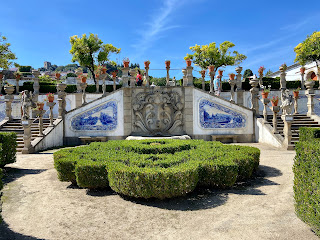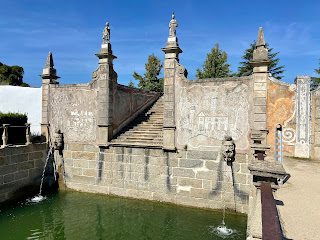We are driving home to Lisbon today. We break our journey in Castelo Branco (pop 52,291 in 2021) for lunch and a walk. We leave the car near the Capela de São Marcos (sixteenth century), where there is a convenient parking lot.
It's a short walk to the Sé de Castelo Branco (de São Miguel, seventeenth century).
A man comes into this world, takes a couple of turns, and departs it, but that is all that’s needed to create and give form to this expression of individual sensibility which then becomes part of our collective experience.It was in this reflective frame of mind that the traveller found himself confronted by the Cathedral, which does not know what to do with the inexpressive façade that was foisted upon it. And inside it is obvious that those charged with the mission of beautifying this temple to St Michael did not put themselves out very much; we can only hope that in his magnanimity the archangel will forgive them their oversight. A lot more forgiveness will be needed, for Bishop Dom Vicente’s pride for example, after the way he has had his coat of arms sculpted over the sacristy door: put briefly, this is nothing more than a delirium of stone. Christ’s only emblem was a rugged cross, but his bishops are going to enter heaven carting with them heraldic puzzles it will take an eternity to solve. (José Saramago, “Journey to Portugal,” 1990; trans Hopkinson-Caistor, 2000)
The entrance to the Sé is from the Sacristia, and we concur with Saramago's traveller on this. The Bishop's coat of arms is not only lavishly displayed over the sacristy door, it's on the ceiling in bright primary colors. There are rococo niches and a gilt altar at the far end – if this is the sacristy, we can only imagine what the cathedral looks like.
But by contrast, the church itself is dim and plain. The walls are courses of unbroken blocks, only a few deep windows in the clerestory provide light. And the artificial lighting in the lateral chapels and the altar is too strong.
Opposite the Sacristia is a lager chapel dedicated to the Last Supper (Capela do Santíssimo Sacramento, eighteenth century), with a striking painting of the Twelve Apostles at a round table (and sucking pig?); Judas is in the foreground with his bag of silver. At least this chapel feels architecturally cohesive. In the glass panels on either side are the Four Evangelists (from left to right): Matthew (angel), Luke (ox), John (eagle), and Mark (lion).
Este é meu Sangueo Sangue da nova aliança,derramado por vós.(Mc. 14,24)[This is my Bloodthe Blood of the new alliance,spilled for you.]
In the main altar is a painting of São Miguel with his spear and shield, under the Eye of Providence. But perhaps the most touching image is of the Sagrada Familia in an unadorned room opposite the baptistry – Father Joseph, Mother Mary, and Jesus in the workshop.
Just down the street is the Cruzeiro de São João (sixteenth century).
Shortly afterwards he’s nearing the palace garden. Here is the crucifix of St John, with stone like lacework, hollowed out in filigree, with not a smooth surface to be seen anywhere. It’s a triumph of curves, scrolls, flourishes. But this crucifix seems lost in a large corner square; it seems out-of-place with all that’s around it, as though it had been transplanted here without much thought. And yet as far as the traveller can tell, it’s always been here. It’s just that at some moment or other, the crucifix became detached from the rest of the square; it was spurned or did the spurning. (José Saramago, “Journey to Portugal,” 1990; trans Hopkinson-Caistor, 2000)
We find the reason for this sense of being "out-of-place" at the nearby Jardim do Paço de Episcopal (eighteenth century). One of the azulejos panels shows the Cruzeiro in front of a small chapel, demolished in the twentieth century. The Cruzeiro now atop a praça that is the roof of a car park.
Now it is time to visit the garden. Whereas Monsanto was the town of stone, here is a gallery of illustrious figures: angelical, apostolic, real, symbolic—but all of them intimately portrayed, close at hand, in the gaps between the shaped box trees. The traveller thinks there cannot be another garden like this in the whole world. If there is, then this is a remarkable copy; if not, then it’s worth a lot of praise. The only drawback he can find is that it is not somewhere to rest or to read a book—anyone entering it should bear that in mind. When the bishops came in here, they doubtless brought their servants with them, and they in turn brought stools for their masters to rest and pray on, but nowadays the common traveller who visits the garden can look round it as much as he or she likes, but will have only the ground or the steps of the staircases to sit on. (José Saramago, “Journey to Portugal,” 1990; trans Hopkinson-Caistor, 2000)
The statues are remarkable, not so much for their artistic value, which is debatable, but for the ingenuity they show, the display of a learned plastic vocabulary. Here are the kings of Portugal, like those of a pack of cards, and here too is the patriotic gesture that meant the kings of Spain were portrayed alongside them on a smaller scale—since they could not be ignored entirely, they were shrunk. Alongside them are the symbolic statues: Faith, Hope and Charity; Spring and the other seasons; and here in a corner facing the wall, Death. The visitors don’t like this particular statue, of course. They stick chewing gum in its empty eye sockets, put cigarettes between its lips. These insults probably mean little to Death. It knows that there is a time for everything. (José Saramago, “Journey to Portugal,” 1990; trans Hopkinson-Caistor, 2000)
A large reservoir completes the upper level of the Jardim. Its balcony serves as a marvelous miradouro, with views over the geometry of the hedgerows and the army of allegorical and historical figures. On the south end of the pool, a small stair leads into the water. We imagine the Bishop taking an cool dip, swimming to the formal stair on the opposite end, and climbing out to survey his creation.
At the conclusion of our visit, we come face to face with Dom Vicente Ferrer de Rocha, Bispo de Castelo Branco. The azulejos likeness is set in his library, as he holds a book of cathechismos. The portrait certainly contains the pride Saramago mentions, but his eyes are haunted and hollow.
The traveller finished his tour, counting all the apostles, looking at the pond shining like an altarcloth in the muddy garden. Back in the town square, he is disappointed to find that the statue to João Ruiz has nothing in common with his verses: he is simply a stuffed shirt dressed like country nobles of his day, not someone who was capable of writing:The sad are so sad to leaveSo hopeless in their goodbyesThat no-one could ever believeThe sadness in their eyes.


























































